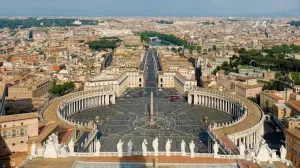The Tradition of Burying Popes in Three Coffins: Symbolism, History, and Practice

When a pope passes away, the Catholic Church follows a series of time-honored rituals to honor the deceased pontiff, one of which includes the distinctive practice of burial in three coffins. This tradition, steeped in symbolism, history, and practicality, underscores the unique role of the pope as the spiritual leader of over a billion Catholics worldwide. While not universally applied to every pope, the use of three coffins—a cypress inner coffin, a lead middle coffin, and an outer wooden coffin—has become a hallmark of papal funerals, particularly for those interred in St. Peter’s Basilica. This article explores the origins, significance, and details of this practice, shedding light on its enduring place in Catholic tradition.
The Three Coffins: Structure and Purpose
The burial of a pope in three coffins is a carefully orchestrated process, with each layer serving distinct practical and symbolic functions. Below is a detailed look at each coffin and its role:
- The Inner Coffin: Cypress Wood
The innermost coffin is crafted from cypress, a simple and humble wood associated with modesty and impermanence. This choice reflects the Christian belief in the fleeting nature of earthly life and the return to dust, as expressed in the biblical phrase, “for dust you are and to dust you will return” (Genesis 3:19). The pope’s body is placed in this coffin, often dressed in simple liturgical vestments, including a white cassock, red chasuble, and a pallium, symbolizing his priestly and apostolic roles.
Alongside the body, certain items are included: a parchment or scroll (known as a rogito) summarizing the pope’s life and achievements, a small pouch of coins minted during his papacy, and papal medals. These items serve as historical markers, ensuring that future generations know the identity and legacy of the pontiff. The cypress coffin embodies the pope’s humanity and humility, stripping away the grandeur of his office in death. - The Middle Coffin: Lead
Encasing the cypress coffin is a lead coffin, which is hermetically sealed to preserve the body and protect it from environmental factors such as moisture and air. This layer is particularly important for popes buried in the crypts of St. Peter’s Basilica, where conditions could accelerate decomposition. The lead coffin is inscribed with the pope’s name, the dates of his birth, death, and papacy, and sometimes a Latin epitaph, transforming it into a historical artifact.
Symbolically, the lead coffin represents the weight of the pope’s responsibilities as the Vicar of Christ and the permanence of his contributions to the Church. Its durability underscores the enduring nature of the papacy, even as individual popes pass away. The sealing of the coffin also serves a practical purpose, ensuring the body remains intact for potential future exhumation, as has occurred in cases of canonization or historical study. - The Outer Coffin: Elm or Oak
The outermost coffin is typically made of a sturdy wood such as elm or oak, chosen for its strength and ability to withstand the rigors of burial and entombment. This coffin provides an additional layer of protection, ensuring the inner coffins remain secure within the tomb or crypt. Its robust construction symbolizes the strength and continuity of the Catholic Church, which endures through the ages despite the death of its leaders.
The outer coffin is often plain but may be adorned with a simple cross or the papal coat of arms, reinforcing the sacred nature of the burial. Together with the other coffins, it completes the physical and symbolic enclosure of the pope’s remains, safeguarding them for posterity.
Historical Origins of the Tradition
The practice of burying popes in three coffins likely draws from a combination of ancient Roman, medieval European, and ecclesiastical traditions. In ancient Rome, elite citizens and emperors were often buried in multiple layers of coffins or sarcophagi, with materials like lead used to preserve remains. Early Christians adopted and adapted these customs, particularly for martyrs and saints, whose bodies were venerated and preserved in churches.
By the Middle Ages, European nobility and high-ranking clergy were frequently buried in double or triple coffins, with lead linings becoming common to protect remains during transport or long-term burial. The papacy, as both a spiritual and temporal institution, naturally incorporated these practices, tailoring them to reflect Christian theology and the unique status of the pope. The use of cypress, lead, and elm or oak likely became standardized over time, particularly for popes buried in St. Peter’s Basilica, where the grandeur and permanence of the Vatican demanded elaborate burial rites.
The triple-coffin tradition may also have been influenced by practical considerations. Popes, as global figures, often attracted pilgrims and visitors to their tombs, necessitating robust burial arrangements to ensure the body’s preservation. Additionally, the Church’s emphasis on the possibility of canonization meant that papal remains needed to be accessible and intact for future examination, as seen in the cases of saints like John XXIII and John Paul II.
Symbolic Significance
Beyond its practical and historical roots, the use of three coffins carries profound spiritual and theological symbolism. While not explicitly mandated by Church doctrine, the triple structure has been interpreted in various ways:
- The Holy Trinity: Some scholars suggest that the three coffins evoke the Christian doctrine of the Trinity—Father, Son, and Holy Spirit. This interpretation aligns with the pope’s role as a representative of Christ on Earth, whose death is enveloped in the divine mystery of God’s triune nature.
- The Threefold Office of the Pope: The coffins may symbolize the pope’s threefold role as priest, prophet, and king. As a priest, he offers the Eucharist and intercedes for the faithful; as a prophet, he teaches and proclaims the Gospel; as a king, he governs the Church. The layers of the coffin reflect these dimensions of his ministry, culminating in his final act of surrender to God.
- Journey to Eternity: The progression from the humble cypress to the durable lead and sturdy oak can be seen as a metaphor for the soul’s journey from earthly life to eternal rest. The cypress represents mortality, the lead signifies the enduring legacy of the papacy, and the oak symbolizes the Church’s eternal foundation in Christ.
These interpretations, while speculative, highlight the rich symbolism embedded in Catholic funeral rites, where every detail is imbued with meaning.
Variations and Exceptions
While the three-coffin burial is a well-known tradition, it is not universally applied. Some popes have been buried more simply, depending on circumstances, personal wishes, or historical context. For example:
- Pope John Paul I (1978): Known for his brief 33-day papacy, John Paul I was buried in a single wooden coffin, reflecting the simplicity of his pontificate and the unexpected nature of his death.
- Pope Pius XII (1958): While Pius XII was buried in three coffins, his body was not embalmed properly, leading to rapid decomposition. This incident prompted improvements in the Vatican’s embalming and burial procedures.
- Pope Francis (2013–present): As of April 2025, Pope Francis has expressed a preference for simplicity in his eventual funeral, advocating for a single wooden coffin and a less elaborate ceremony. Whether this will override the three-coffin tradition remains to be seen.
Additionally, not all popes are buried in St. Peter’s Basilica. Some, like Celestine V, were interred in other locations, and their burial arrangements varied based on local customs or the pope’s wishes. The three-coffin practice is most closely associated with the Vatican’s standard protocol for pontiffs laid to rest in Rome.
The Burial Process
The burial of a pope in three coffins is part of a broader sequence of funeral rites, which typically unfold as follows:
- Preparation of the Body: After the pope’s death is confirmed, the body is cleaned, dressed in liturgical vestments, and sometimes embalmed to allow for public viewing. The body is placed in the cypress coffin, along with the rogito, coins, and medals.
- Lying in State: The pope’s body is displayed in St. Peter’s Basilica for several days, allowing the faithful to pay their respects. The cypress coffin remains open during this period.
- Sealing the Coffins: After the public viewing, the cypress coffin is closed and placed inside the lead coffin, which is soldered shut. The lead coffin is then encased in the outer wooden coffin, often during a private ceremony attended by Vatican officials.
- Entombment: The triple coffin is interred in the Vatican Grottoes (the crypt beneath St. Peter’s Basilica) or another designated location. A simple marble slab or ornate tomb marks the burial site, often inscribed with the pope’s name and dates.
These steps are accompanied by Masses, prayers, and rituals that emphasize the pope’s role as a servant of God and the Church’s hope in the resurrection.
Conclusion
The tradition of burying popes in three coffins is a fascinating blend of practicality, history, and symbolism, reflecting the Catholic Church’s reverence for its leaders and its deep theological traditions. From the humble cypress coffin to the durable lead and oak layers, each element serves to honor the pope’s legacy while protecting his remains for posterity. While variations exist, and modern popes like Francis may advocate for simpler burials, the three-coffin practice remains a powerful symbol of the papacy’s enduring role in the life of the Church.
As the Catholic Church continues to evolve, the rituals surrounding papal burials may adapt to new sensibilities, but the rich symbolism of the three coffins will likely remain a touchstone for understanding the sacred transition from earthly leadership to eternal rest. For those intrigued by this tradition, the crypts of St. Peter’s Basilica stand as a testament to its historical and spiritual significance, inviting reflection on the lives and legacies of the men who have served as successors to St. Peter.




